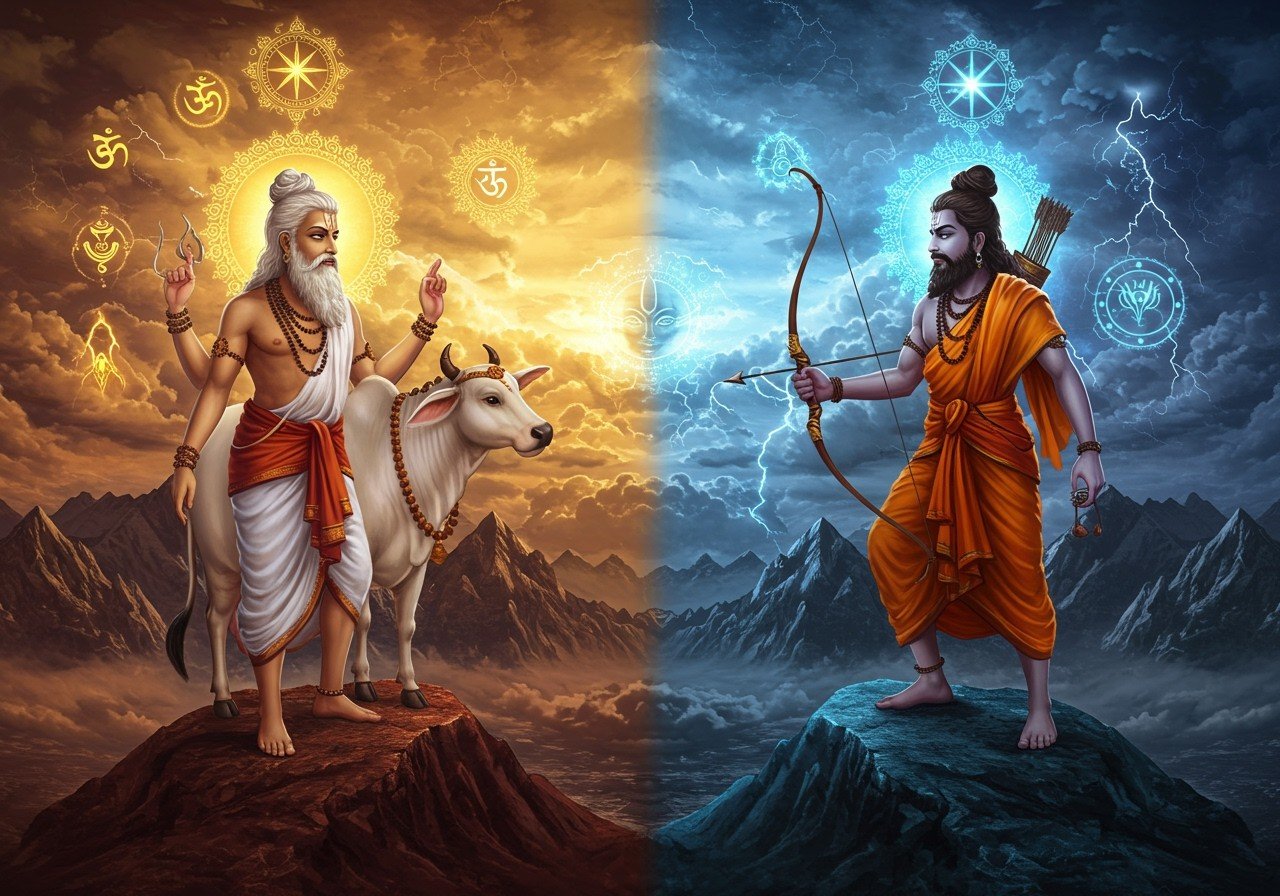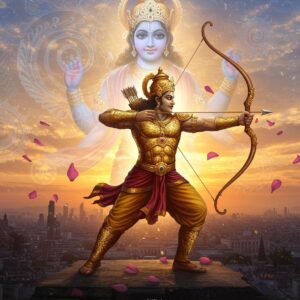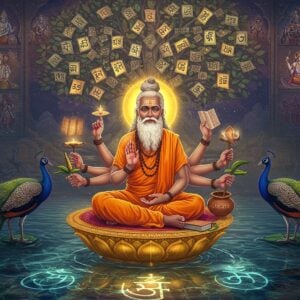
In Indian mythology, the legendary rivalry between sages Vashistha and Vishwamitra is a tale rich with lessons and insights. Deeply rooted in ancient scriptures, this story reflects the struggle between spiritual wisdom and worldly power. This narrative holds cultural significance for many Indians who cherish tradition and heritage. Let’s explore their complex relationship, the events that fueled their conflict, and the valuable lessons it offers today. You can find items related to rituals and practices mentioned in this blog at Poojn.in.
Historical Context and Characters
Sage Vashistha is a revered Brahmarishi, representing the pinnacle of spiritual knowledge and wisdom. Known for his deep insight, Vashistha served as a spiritual advisor to the kings of the Solar dynasty, guiding them with his unwavering commitment to dharma. For books and other holy items related to Vashistha’s teachings, visit Poojn.in’s Holy Books collection.
Vishwamitra, originally a powerful king named Kaushika, chose a different path. He renounced his royal life, seeking the status of Brahmarishi. His ambition and determination marked his challenging spiritual journey. Explore our collection of Decoratives at Poojn.in to enhance your spiritual space.
The rivalry between Vashistha and Vishwamitra symbolizes the eternal conflict between spiritual wisdom and material power. This narrative captures the essence of two distinct paths: Vashistha’s rooted wisdom and Vishwamitra’s relentless quest for spiritual stature. Their story remains relevant, offering insights into balancing power with wisdom.
The Origin of the Rivalry
The conflict between Vashistha and Vishwamitra began with the divine cow Kamadhenu, also known as Nandini. Vishwamitra, a powerful king, desired Kamadhenu, believing she could fulfill his worldly desires. Vashistha, possessing immense spiritual powers, refused to relinquish the sacred cow. Despite his military strength, Vishwamitra was defeated by Vashistha’s spiritual prowess, igniting a deep desire for revenge and sparking their epic rivalry. Delve deeper into the narrative with our selection of Ramayana’s influence on spirituality.
Escalation and Vishwamitra’s Penance
Driven by his defeat, Vishwamitra embarked on a rigorous spiritual journey, performing intense penance to surpass Vashistha. Through his austerities, he received blessings from Lord Shiva and acquired celestial weapons. This newfound power led him to attack Vashistha’s hermitage, tragically causing the death of Vashistha’s sons. However, Vashistha wielded the Brahmadanda, a divine staff capable of neutralizing any weapon, defending himself against Vishwamitra’s attacks. Explore more about the complexities of Ravana, another powerful figure in Hindu mythology, at Poojn.in.
Vishwamitra’s Transformation and Reconciliation
Vishwamitra’s journey from king to sage is a testament to his unwavering determination. He overcame numerous temptations and divine tests, including encounters with Menaka and Rambha, celestial nymphs sent to disrupt his penance. His perseverance led him to compose the Gayatri Mantra, a highly revered hymn in Hindu spirituality. Through relentless penance, Vishwamitra ultimately attained the status of Brahmarishi, reconciling with Vashistha. This reconciliation signifies the harmonious balance between power and wisdom. Learn more about Valmiki, the author of the Ramayana at Poojn.in. You can also explore lessons on loyalty and sacrifice from the Ramayana at Poojn.in.
Cultural Significance and Modern Relevance
The Vashistha-Vishwamitra rivalry remains deeply ingrained in Indian culture. It appears in various forms of art, literature, and performances, serving as a source of moral and philosophical lessons. In today’s materialistic world, this story emphasizes the enduring relevance of spiritual wisdom. Its portrayal in popular media, including television series and films, continues to shape public perception of these iconic figures, inspiring individuals to appreciate tradition and spirituality. Enhance your understanding of Hindu rituals with authentic puja items available at Poojn.in.
Poojn.in: Honoring the Sacred Legacy
At Poojn.in, we offer a wide selection of products to support your spiritual practices, including those related to the teachings of Vashistha and Vishwamitra. Our collection features pure copper kalash, traditional kusha grass, authentic yagna samagri, premium ghee, handpicked tulsi leaves and garlands, and pure cotton yagnopavit (sacred thread). You can also find Sindoor at Poojn.in and Clay Pooja Ghat at Poojn.in. Visit www.poojn.in to explore our complete range of authentic puja items.
Reflecting on Timeless Wisdom
The story of Vashistha and Vishwamitra is more than just a rivalry; it’s a journey of spiritual wisdom. It teaches us that true strength lies not in physical power but in inner resilience and humility. Vishwamitra’s transformation highlights the power of perseverance and spiritual growth. This tale remains relevant today, reminding us to seek balance in life, allowing spiritual wisdom to guide our ambitions. By embracing these teachings, we honor our traditions and enrich our spiritual journeys.
FAQs
What was the primary cause of the rivalry between Vashistha and Vishwamitra? The rivalry stemmed from Vishwamitra’s desire to possess Kamadhenu, Vashistha’s divine cow, and his subsequent defeat by Vashistha’s spiritual power. This sparked Vishwamitra’s ambition to surpass Vashistha.
What motivated Vishwamitra to compete with Vashistha? Vishwamitra’s initial motivation was the acquisition of Kamadhenu. However, his defeat transformed this desire into a quest for spiritual attainment equal to or greater than Vashistha’s.
How did their rivalry shape Hindu mythology? This rivalry is a crucial narrative, highlighting themes of perseverance, spiritual evolution, and the pursuit of knowledge. It showcases Vishwamitra’s transformation, illustrating the potential for profound spiritual growth.
What key lessons can we draw from their story? The tale emphasizes humility, resilience, and the understanding that true power resides in wisdom. It also underscores the importance of self-improvement and the pursuit of spiritual fulfillment.
Did Vishwamitra ever reach Vashistha’s level of spiritual power? Yes, through dedicated penance, Vishwamitra achieved the status of Brahmarishi, equivalent to Vashistha, demonstrating the potential for spiritual ascension through determination.
How does this rivalry reflect human nature? The story mirrors our inherent tendencies to compete and strive for greatness, depicting the ongoing struggle between ego and wisdom. It encourages us to seek self-growth and inner peace.
Does the story of Vashistha and Vishwamitra hold relevance today? Absolutely. It encourages us to balance ambition with humility and to prioritize spiritual growth alongside worldly achievements.


